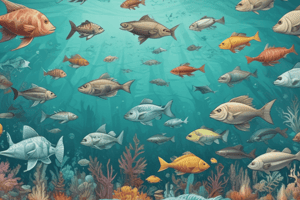Podcast
Questions and Answers
குடும்ப அங்கத்தவர்களில் ஒருவர் அப்பா
குடும்ப அங்கத்தவர்களில் ஒருவர் அப்பா
சரி (A)
இரண்டு கால்கள் கொண்ட பிராணி மாடு ஆகும்.
இரண்டு கால்கள் கொண்ட பிராணி மாடு ஆகும்.
பிழை (B)
வீட்டுக்கு வரும் உறவினர்களில் மாமாவும் ஒருவராவார்.
வீட்டுக்கு வரும் உறவினர்களில் மாமாவும் ஒருவராவார்.
சரி (A)
கத்தரி செடிவகைத் தாவரமாகும்.
கத்தரி செடிவகைத் தாவரமாகும்.
கட்டில் வகுப்பறையில் காணப்படும் ஒரு உபகரணமாகும்.
கட்டில் வகுப்பறையில் காணப்படும் ஒரு உபகரணமாகும்.
Food chains are isolated and do not interact with each other.
Food chains are isolated and do not interact with each other.
உயிரியல் பல்வகைமை என்பது ஒரு சுற்றாடலில் உள்ள தாவரங்கள், விலங்குகள், சிறுநீர்கள் ஆகியவற்றின் எண்ணிக்கையை மட்டும் குறிக்கிறது.
உயிரியல் பல்வகைமை என்பது ஒரு சுற்றாடலில் உள்ள தாவரங்கள், விலங்குகள், சிறுநீர்கள் ஆகியவற்றின் எண்ணிக்கையை மட்டும் குறிக்கிறது.
இனங்களின் பல்வகைமை என்பது ஒரு சுற்றாடலில் உள்ள பல்வேறு இனங்களின் எண்ணிக்கையைக் குறிக்கிறது.
இனங்களின் பல்வகைமை என்பது ஒரு சுற்றாடலில் உள்ள பல்வேறு இனங்களின் எண்ணிக்கையைக் குறிக்கிறது.
சுற்றாடல் சேவைகள் என்பது காற்று, நீர் தூய்மை, மண்ணாக்கத் தொடர்பான சேவைகளைக் குறிக்கிறது.
சுற்றாடல் சேவைகள் என்பது காற்று, நீர் தூய்மை, மண்ணாக்கத் தொடர்பான சேவைகளைக் குறிக்கிறது.
பல்வகைமையின் முக்கியத்துவம் உணவு பாதுகாப்பு, மருந்து ஆகியவற்றில் மட்டும் உள்ளது.
பல்வகைமையின் முக்கியத்துவம் உணவு பாதுகாப்பு, மருந்து ஆகியவற்றில் மட்டும் உள்ளது.
உயிரியல் பல்வகைமையை அழிக்கும் காரணிகளில் சூழல் அழிவு, காலநிலை மாற்றம், அதிக பயன்பாடு ஆகியவை உள்ளன.
உயிரியல் பல்வகைமையை அழிக்கும் காரணிகளில் சூழல் அழிவு, காலநிலை மாற்றம், அதிக பயன்பாடு ஆகியவை உள்ளன.
உயிரியல் பல்வகைமையை பாதுகாக்கும் நடவடிக்கைகள் எதுவும் இல்லை.
உயிரியல் பல்வகைமையை பாதுகாக்கும் நடவடிக்கைகள் எதுவும் இல்லை.
Flashcards are hidden until you start studying
Study Notes
சுற்றாடல் (Ecosystem)
Food Chain
A food chain is a series of organisms that eat other organisms, with each level representing a trophic level.
Components of a Food Chain:
- Producers: Autotrophic organisms like plants, phytoplankton, and algae that produce their own food through photosynthesis.
- Primary Consumers: Herbivores that feed on producers, such as insects, rodents, and deer.
- Secondary Consumers: Carnivores that feed on primary consumers, such as frogs, snakes, and birds of prey.
- Tertiary Consumers: Apex predators that feed on secondary consumers, such as sharks, lions, and top predators.
- Decomposers: Organisms like bacteria and fungi that break down dead organic matter.
Characteristics of a Food Chain:
- Energy is transferred from one trophic level to the next, with some energy lost as heat at each level.
- Each trophic level has a specific role and is dependent on the previous level.
- Food chains are interconnected and form a complex network.
Types of Food Chains:
- Grassland Food Chain: Producers → Herbivores → Carnivores → Apex Predators
- Aquatic Food Chain: Phytoplankton → Zooplankton → Fish → Top Predators
- Forest Food Chain: Trees → Insects → Small Mammals → Large Predators
Ecosystem: Food Chain
- A food chain is a series of organisms that eat other organisms, with each level representing a trophic level.
Components of a Food Chain
- Producers: autotrophic organisms like plants, phytoplankton, and algae that produce their own food through photosynthesis.
- Primary Consumers: herbivores that feed on producers, such as insects, rodents, and deer.
- Secondary Consumers: carnivores that feed on primary consumers, such as frogs, snakes, and birds of prey.
- Tertiary Consumers: apex predators that feed on secondary consumers, such as sharks, lions, and top predators.
- Decomposers: organisms like bacteria and fungi that break down dead organic matter.
Characteristics of a Food Chain
- Energy is transferred from one trophic level to the next, with some energy lost as heat at each level.
- Each trophic level has a specific role and is dependent on the previous level.
- Food chains are interconnected and form a complex network.
Types of Food Chains
- Grassland Food Chain: producers → herbivores → carnivores → apex predators.
- Aquatic Food Chain: phytoplankton → zooplankton → fish → top predators.
- Forest Food Chain: trees → insects → small mammals → large predators.
Definition of Biodiversity
- Biodiversity refers to the variety of different species of plants, animals, and microorganisms that live in an ecosystem or on Earth as a whole.
- It also includes genetic diversity within each species, variety of ecosystems, and interactions between different species and their environment.
Types of Biodiversity
- Species diversity: Number of different species present in an ecosystem.
- Genetic diversity: Variety of genes within a species or population.
- Ecosystem diversity: Variety of different ecosystems present in an area, such as forests, grasslands, and deserts.
Importance of Biodiversity
- Ecosystem services: Biodiversity provides essential services like air and water purification, soil formation, and climate regulation.
- Food security: Many crops and livestock rely on biodiversity to pollinate, control pests, and maintain soil health.
- Medicine: Biodiversity is a source of new medicines and treatments for human diseases.
Threats to Biodiversity
- Habitat destruction: Human activities like deforestation, land conversion, and pollution lead to habitat loss and fragmentation.
- Climate change: Rising temperatures and changing weather patterns affect the distribution and extinction of species.
- Overexploitation: Overhunting, overfishing, and unsustainable harvesting of resources threaten biodiversity.
Conservation of Biodiversity
- Protected areas: National parks, wildlife reserves, and other protected areas help preserve habitats and ecosystems.
- Sustainable practices: Sustainable agriculture, forestry, and fishing reduce the impact of human activities on biodiversity.
- Education and awareness: Raising awareness about the importance of biodiversity and the threats it faces inspires individual and collective action to conserve it.
Studying That Suits You
Use AI to generate personalized quizzes and flashcards to suit your learning preferences.



